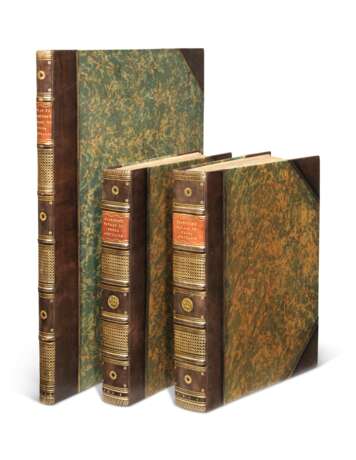ID 519375
Lot 84 | Matthew Flinders (1774-1814)
Estimate value
£ 8 000 – 12 000
A Voyage to Terra Australis; undertaken for the purpose of completing the discovery of that vast country, and prosecuted in the years 1801, 1802, and 1803, in his Majesty's Ship the Investigator. London: W. Bulmer and Co. for G. and W. Nicol, 1814.
First edition documenting the first circumnavigation of Australia; ‘the most outstanding book on the coastal exploration of Australia …Such is the historical importance of this monumental work that no general collection of Australian books can be considered complete without it’ (Wantrup, p.144). The work covers Flinders’ nine years of coastal exploration which culminated in the first complete and definitive circumnavigation of the Australian continent through the newly discovered Bass Strait.
Vol. I of the work contains a long introduction covering the history of voyages of exploration to Australia from the yacht Duyhen in 1605 to Bligh in 1791, as well as Flinders’ coastal surveying voyages with George Bass in 1795-1797 which determined the existence of Bass Strait.
The remainder comprises a narrative of the voyage of the Investigator, a commission Flinders secured by successful petitioning of the Admiralty by his patron Sir Joseph Banks. He sailed in 1801 with the young John Franklin and the landscape artist William Westall, together with the natural history artist Ferdinand Bauer. It contains sailing directions for the coasts explored, descriptions of areas visited, particulars of geology, botany, fauna, and also of the Aboriginal peoples encountered. The first proposals to establish a colony on the south coast and a new penal settlement on the east coast were based on Flinders' descriptions of the country.
The charts Flinders produced on this voyage were so accurate that they were re-issued by the Admiralty for many decades and form the basis for many modern charts of the Australian coastline. Appended are Longitude tables and notes on compass variation, since Flinders was the first to correct compass errors caused by iron in ships. He also first proposed the name Australia to include both the continent and Tasmania. Returning to England in 1803 in the Cumberland via Mauritius he was imprisoned as a spy there for nearly seven years where he wrote much of this work. The work was eventually seen through the press in 1814, but by this time Flinders was dying, and a contemporary tradition holds that he received the published work on 19 July of that year, the last day of his life. Ferguson 576; Hill 614; Ingelton 6487; Kroepelien 438; Nissen BBI 367; Stafleu & Cowan TL2 1806; Wantrup 67a; Tooley, Mapping of Australia, pp.77-79.
3 volumes: comprising 2 volumes text, quarto (312 x 240mm) and folio atlas (475 x 380mm). 9 engraved plates by William Westall in text volumes (lacking half-titles, browning, staining and soiling to plates in text vols, textblock with some light staining and soiling mainly confined to margins, with a few leaves dogeared at end of vol. I, tiny marginal holes to T4 and quire 3F in vol. II). Atlas with 16 folding maps, 2 double-page coastal profiles bound as 4 folding plates, and 10 botanical plates after Ferdinand Lukas Bauer (some light offsetting to maps, a few small holes at creasefolds). Uniformly bound in modern dark-brown half morocco, gilt spines.
| Address of auction |
CHRISTIE'S 8 King Street, St. James's SW1Y 6QT London United Kingdom | |
|---|---|---|
| Preview |
| |
| Phone | +44 (0)20 7839 9060 | |
| Buyer Premium | see on Website | |
| Conditions of purchase | Conditions of purchase |








